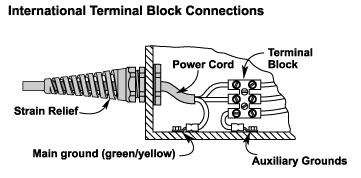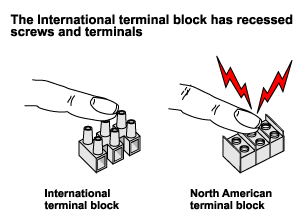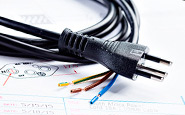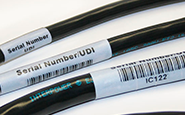More Information on Terminal Blocks
Interpower terminal blocks described in this section are intended specifically for use in making the internal connection between the power cord and the primary circuitry of the equipment. Three-contact terminal blocks provide connection points in single-phase applications with terminals for line, neutral, and ground. Five-contact terminal blocks are used in three-phase applications with terminals for three lines, neutral or common, and ground.
Use, Assembly, and Safety Features
International power entry connection practices, as outlined in IEC 60335 and other international equipment standards, are different from practices commonly observed in North America and officially sanctioned by UL and CSA. Interpower terminal blocks meet both North American and international standards.
International standards require that equipment using permanently attached power cords be constructed such that cords can be disconnected and removed from the equipment without the use of any specialized tools, such as soldering irons. Screwdrivers and wrenches are allowed. The theory behind these requirements is that equipment repair is likely to take place at the user location and be performed by personnel who have a limited understanding of the equipment itself. The assumption is that tools and skills may be limited and therefore, the power cord connection process should be simple.
The drawing below illustrates an installation that complies with international requirements. The cord enters the product through a strain relief, which can be released by using a wrench. It does not have to be removed from the panel in order to release the cable.

The cord is attached to a terminal block, which is constructed so that a screwdriver is the only tool required to connect or disconnect it. Solder-type terminal strips are not permissible.
Safety Features
The terminal block must be constructed so that creepage and clearance distances between lines, as well as line and ground, are maintained. Finally, the insulation construction must prevent contact with current-carrying surfaces in an attempt to eliminate the possibility of accidental shock. This is accomplished on the terminal blocks by recessing screws and terminals so they are screwdriver accessible only (illustration below). In this case, screwdriver accessibility means that the standard test finger, which is described in international standards, cannot touch current-carrying surfaces when the terminal block is assembled with wires in place. Standard North American terminal blocks do not satisfy this requirement.




